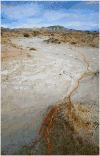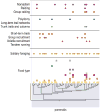Spatiotemporal resource distribution and foraging strategies of ants (Hymenoptera: Formicidae)
- PMID: 25525497
- PMCID: PMC4267257
Spatiotemporal resource distribution and foraging strategies of ants (Hymenoptera: Formicidae)
Abstract
The distribution of food resources in space and time is likely to be an important factor governing the type of foraging strategy used by ants. However, no previous systematic attempt has been made to determine whether spatiotemporal resource distribution is in fact correlated with foraging strategy across the ants. In this analysis, I present data compiled from the literature on the foraging strategy and food resource use of 402 species of ants from across the phylogenetic tree. By categorizing the distribution of resources reported in these studies in terms of size relative to colony size, spatial distribution relative to colony foraging range, frequency of occurrence in time relative to worker life span, and depletability (i.e., whether the colony can cause a change in resource frequency), I demonstrate that different foraging strategies are indeed associated with specific spatiotemporal resource attributes. The general patterns I describe here can therefore be used as a framework to inform predictions in future studies of ant foraging behavior. No differences were found between resources collected via short-term recruitment strategies (group recruitment, short-term trails, and volatile recruitment), whereas different resource distributions were associated with solitary foraging, trunk trails, long-term trail networks, group raiding, and raiding. In many cases, ant species use a combination of different foraging strategies to collect diverse resources. It is useful to consider these foraging strategies not as separate options but as modular parts of the total foraging effort of a colony.
Keywords: Review; collective behavior; evolution; framework; group recruitment; honeydew; networks; pheromone; phylogeny; trunk trails.
Figures







References
-
- Abbott KL. Supercolonies of the invasive yellow crazy ant, Anoplolepis gracilipes, on an oceanic island: Forager activity patterns, density and biomass. Insectes Sociaux. 2005;52:266–273.
-
- Acosta FJ, Lopez F, Serrano JM. Dispersed versus central-place foraging – intracolonial and intercolonial competition in the strategy of trunk trail arrangement of a harvester ant. The American Naturalist. 1995;145:389–411.
-
- Adams ES. Territory defense by the ant Azteca trigona – maintenance of an arboreal ant mosaic. Oecologia. 1994;97:202–208. - PubMed
-
- Anonymous. Tawny (rasberry) Crazy Ant Nylanderia fulva. 2010 < http://urbanentomology.tamu.edu/ants/rasberry.html>, retrieved on 1 May 2013.
-
- AntWeb. AntWeb. 2002 < http://www.antweb.org>, retrieved 2013.
Grants and funding
LinkOut - more resources
Full Text Sources
